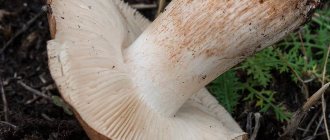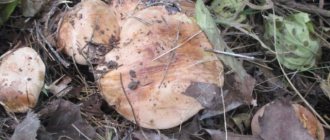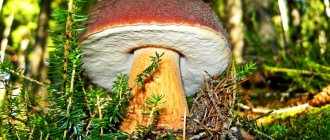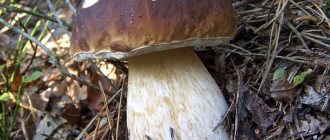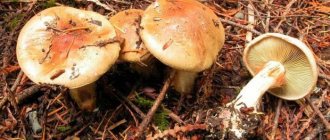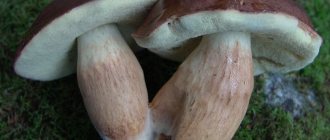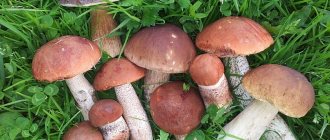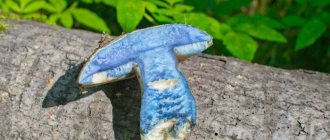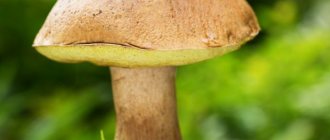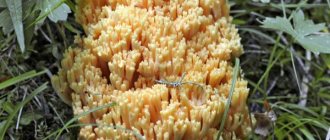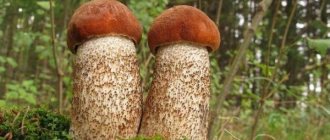» Mushrooms » Purple mushrooms: can they be eaten?
0
2463
Article rating
It is not uncommon to encounter purple mushrooms in the forest. Their exotic appearance attracts the attention of many. Among them there are both edible and non-edible varieties. Knowing the name of the specimen and its detailed description, you will never confuse edible with toadstool.
- Color changing mushrooms
- How to distinguish from false ones
- Camphor milk mushroom
- Umbrella purple
- Goat's web
- Mycena pure
- Where do purple mushrooms grow?
- Beneficial features
- Contraindications
- Areas of application
- In cooking
- In medicine
Purple mushrooms: can they be eaten?
Edible varieties
This group includes several tasty subspecies that are readily used in medicine and cooking.
Cobweb
The lamellar mushroom is popularly called violet or fat mushroom.
An autumn species, prefers to grow in deciduous and coniferous forests.
The characteristic includes several special qualities:
- head cushion-shaped or convex with a circumference of 15 cm;
- in adult and old mushrooms the cap is spread out, the edges are wavy, covered with scales, the color is dark purple with a gray tint;
- the plates are wide, sparsely spaced, purple;
- the height of the cylindrical leg is 12 cm, thickness - 2 cm, the upper part is scaly, the lower part is tuber-shaped;
- the flesh is bluish or with a pronounced nutty taste without a mushroom aroma.
Purple webwort forms mycorrhiza with several types of deciduous trees - beech, oak, birch. It can also be found next to spruce, pine, under fallen leaves, in places where mosses grow, where the soil is acidic and humus.
Peak fruiting occurs at the end of summer and ends in mid-autumn.
Purple dog
Another edible variety that belongs to macromycetes. It grows mainly in groups in places of old fires and fire pits. It begins to bear fruit in the spring and continues until mid-summer.
Description:
- the cap is of two types - disc-shaped or cup-shaped, the circumference of the apex is from 1 to 3 cm;
- the surface is smooth, lilac or reddish-violet;
- in some species a false leg may form;
- The pulp is brittle, pale purple, thin, odorless and aromaless.
Mushroom pickers rarely collect representatives of this species due to their low taste.
Ryadovka
For many mushroom pickers it is known as violet lepista or naked. Popularly called titmouse or cyanosis.
Detailed description:
- the top is fleshy, with a circumference of 16 to 19 cm, hemispherical or convex with thin edges turned down;
- adult fruiting bodies take on a prostrate or depressed shape, the edges are curved, in some specimens the caps are wavy-curved;
- the surface is glossy, in young mushrooms it has a rich purple hue, in old ones it fades and becomes ocher;
- pulp with a mild mushroom taste and aroma reminiscent of anise;
- the plates are violet, thin, densely located;
- the legs are dense, cylindrical in shape, with a thickened base, fibrous structure. In old mushrooms, cavities appear in the thickness of the stem;
- The main difference between the mushroom is the flaky coating and pubescence at the bottom.
Purple rowers are quite large; they prefer to grow under fallen, rotting leaves. They are found both singly and in groups.
Amethyst lacquer
Lakovitsa is listed in the Red Book
This mushroom of the Rowadovaceae family belongs to the group of edibles, but is rare in our country, therefore it is listed in the Red Book. Likes to grow on moist soil in coniferous forests.
It has several distinctive features:
- cap circumference - 1-5 cm depending on age;
- in young specimens the cap is hemispherical, in old fruiting bodies it is flat;
- the main color is lilac-violet, fades with age;
- the plates are thick, the same color as the cap, later becoming white;
- cylinder leg, fibrous, purple;
- In cross section, the fruiting body is purple.
Distribution and collection
Purple talker grows almost everywhere above the Equator, as well as in Australia. It is a saprotroph and grows on humus from needles or leaves. The fungus can also grow on a compost heap. These mushrooms can be found either individually or in clusters arranged concentrically (popularly this arrangement is called “witch’s circles”).
The growth of purple rows is observed from mid-summer until winter; they are resistant to the first frosts.
Color changing mushrooms
In nature, there is one such species - the goat or lattice. This mushroom is a representative of the Buttercup genus and has a yellowish-brown cap covered with mucus, the circumference of which varies from 3 to 12 cm, depending on age.
At the beginning of growth, the surface of its cap is cushion-shaped, later it becomes flat, smooth and sticky.
The leg is 10 cm long, not too thick - up to 2 cm, elastic, cylindrical, a couple of shades lighter than the head, matte. In cross-section, the fruit body is light, does not lose any smell or aroma, and is dense.
If after cooking such mushrooms become dark lilac or purple in color, do not worry, this is a common occurrence.
Appearance
The purple mushroom, according to the description, has a cap with a diameter of up to 15 cm. Its shape is convex, the edges are tucked in or completely lowered. With age, it becomes completely flat. The color is rich, dark purple, there are scales.
The plates are wide, sparse, the color is dark, even bright purple.
The pulp is dense, blue in color, and fades as the mushroom grows. A cross-section of mature mushrooms clearly shows that it turns white. There is a nutty taste, almost no aroma.
The leg has a height of 6-12 cm and a thickness of 1-2 cm. Its upper part has a finely scaly coating, and there is a seal at the bottom.
How to distinguish from false ones
Not only edible, but also poisonous varieties can have a purple color. To learn to distinguish them, you need to read the description.
Camphor milk mushroom
This species is classified as conditionally edible. The fruiting body contains muscarinic substances, which are poisonous and can cause severe intoxication.
():
When muscarine poisoning occurs, a whole complex of symptoms occurs, which experts call “muscarinic syndrome.” Signs of it appear within 30 minutes to 2 hours after eating mushrooms containing these compounds. Studies have shown that the mechanism of action of muscarine on the human body is comparable to that of the poisonous gas Sarin.
The cap of the fruiting bodies is light chestnut or pale yellow with a purple tint, turning brown where pressed.
After some time, the cut purple flesh acquires a red-brown tint and emits the smell of camphor, so it is difficult to confuse it with other species, although completely inexperienced mushroom pickers can do this. When broken, the mushroom releases clear juice.
Umbrella purple
This is not a poisonous mushroom, but due to the unpleasant aroma and the presence of bitterness in the pulp, it is not eaten.
The description includes several features:
- the cap is semi-round, later becoming prostrate;
- the surface is slightly wrinkled, dry, scaly;
- its circumference varies from 5 to 10 cm;
- at the beginning of growth, the color of the cap is snow-white with a slight purple tint and scales, later it acquires an amethyst-brown tone;
- the leg is cylindrical, often curved, whitish, contains a powdery coating at the top, and is covered with numerous light brown scales at the bottom;
- the plates are white, slightly wavy.
Goat's web
This lamellar poisonous mushroom is often confused with the purple cobweb.
The external characteristics are similar, but there is one main difference - the unpleasant smell of acetone, which is emitted by the inedible mushroom.
Goat's web spiders have purple, sometimes even blue, caps. Another distinctive feature is the presence of a skirt with a leg in the form of a belt.
Mycena pure
Mycena pure is very dangerous
This dangerous double of the amethyst lacquer belongs to hallucinogenic mushrooms and is characterized by the presence of muscarine.
The main difference is the presence of whitish or gray-yellow plates under the cap. This species produces a rare aroma (from weak to intense).
Description
Due to the unusual color, mushroom pickers are afraid to collect the purple row. And it’s completely in vain: this mushroom tastes quite good. However, this row is similar in appearance to some poisonous mushrooms, so it is important to have a good understanding of their differences.
hat
The young violet talker really lives up to its name in color; in adulthood it turns brownish. The diameter of the mature mushroom cap reaches 20 cm.
Its shape in young specimens is spherical; over time, the edges open up, causing the cap to become flat with a rounded edge. The surface is smooth, moist, shiny at high humidity.
Leg
The leg is cylindrical with a thickening at the bottom. The legs reach 10 cm in length and 2 cm in thickness. From intense purple at a young age, the color of the legs becomes close to white over time.
The surface is slightly rough: in the upper part there is a light coating, and in the lower part there is mycelium in the form of a light lilac fluff.
Spore-bearing layer
Violet lamellar hymenophore. The plates can be either light or dark purple. They are thin and closely spaced.
Pulp
The flesh is bluish-lilac, marbled. Has a pleasant anise aroma. In small mushrooms it is dense and elastic, in mature ones it softens and turns brown with age.
Spore powder
The mass of spores is pinkish or yellowish-pink. The spores themselves are small, rough and elliptical.
Beneficial features
Purple mushrooms are good for the body. because have a rich composition:
- microelements - manganese, iron, potassium, calcium, sodium, copper, zinc;
- thiamine;
- riboflavin;
- vitamins of group B, as well as PP, A, E;
- cellulose.
Fruiting bodies have a positive effect on the functioning of all internal systems, improve the general condition of the skin, nails, hair, increase immunity against various diseases and help eliminate waste and toxins. They help many people lose weight because... considered low in calories.
Similar species
The violet row has several “doubles” and not all of them are harmless.
Here are harmless mushrooms (edible) that look like the purple row:
It differs in the color of the cap, which is closer to gray, but the leg is also purple.
A mushroom with a pinkish surface and white flesh.
The stalk has a ring-shaped growth from ruptured velum.
It is smaller in size and has a thinner stem.
There are also poisonous specimens among similar mushrooms:
- White-violet cobweb
It is distinguished by a ring-shaped growth on the stalk, which, in contrast to the remnant of the purple cobweb velum, has a rusty color.
- Goat's web
It differs in that its flesh is yellow and smells bad.
- Mycena pure
A hallucinogenic poisonous mushroom, it is distinguished by a browner color and hymenophore plates visible through the cap.
If you want to collect a mushroom such as purple row, it is recommended that you first carefully read the list of similar mushrooms and understand their differences in order to avoid poisoning.
Areas of application
In cooking
Before cooking, the fruiting bodies are subjected to heat treatment - boiled over medium heat in salted water for at least 20 minutes.
Then they are used to prepare salads, appetizers, first and second courses. They are also excellent marinated and salted.
To get a tasty and aromatic preparation, you should follow clear instructions:
- Peel the mushrooms, rinse, cut into pieces, and boil in salted water for 40 minutes. Then drain in a colander.
- Next you need to prepare a marinade from several ingredients - water (1 l), salt (2 tbsp), sugar (1 tbsp) and 2 pinches of citric acid. Additionally, you can add bay leaves (1-2 pcs.), black pepper - 3-4 peas, a little greenery (dill umbrellas) and 2-3 large cloves of garlic (can be cut into pieces). Mix all ingredients and boil for a couple of minutes. When preparing marinade, it is important to remember that iodized salt is not suitable for these purposes.
- Pour the boiling marinade over the mushrooms, previously placed in clean jars. Sterilize for 15 minutes, pour 1-2 tbsp on top. vegetable oil.
- It is important that the mushrooms are completely covered with the marinade, otherwise they will quickly deteriorate.
- Roll up with tin lids, wrap in a blanket, and after cooling, take out for storage in a cellar or basement.
You can try this preparation only after three weeks, so that it has time to become saturated with all the aromas.
Purple web spider (Cortinarius violaceus)
The rows are purple. Popular edible mushrooms. How to recognize. Unique and rare mushrooms in the forest.
Autumn mushrooms. Purple row.
Growing bluelegs at home
The purple-legged rower can be grown at home and the mushrooms can be harvested several times a year. The mycelium can be added to the garden soil or the blueleg can be grown in suitable indoor areas.
Growing mushrooms in the garden
To grow bluelegs, you need to prepare compost, which is a nutrient medium for this type of mushroom. It can be prepared in several ways:
- mix 12 kg of dry, unrotted straw with fresh cow manure (8 kg), preparation time for the composition is about 25 days;
- mix 12 kg of straw with 8 kg of fresh bird droppings, preparation time – 24-26 days;
- mix 12 kg of straw with 8 kg of fresh horse manure, preparation time – 22-24 days;
Growing bluelegs in the garden is not difficult. It is best to plant the crop in May, although this can also be done in the fall. The only condition is that the air temperature should not be below +15 degrees. You can grow bluelegs in the garden either in beds or in boxes or bags.
After planting in the ground, the substrate with the mycelium added to it is covered and regularly moistened. When, after 2-3 weeks, purple areas (mycelium) appear on the substrate, you need to apply a damp layer of soil (5 cm) on top, covering the culture.
After 2-3 weeks, the mycelium will appear on the soil surface. The covering layer should always remain moderately moist.
The blue leg will be able to withstand the winter cold. In the fall, when the temperature drops below 5 degrees, the beds with mushrooms must be covered with bags, and a layer of straw or foliage, the thickness of which must be at least 10 cm, should be poured on top. In the spring, this covering can be removed when the temperature rises above 10 degrees.
Watch the video in which a mushroom picker shares his experience of growing these mushrooms on his site:
Growing blueleg indoors
Lilac-legged rowers can also be bred indoors. They should maintain a temperature within +10-15 degrees.
Also, in rooms intended for breeding bluelegs, there must be a high level of humidity. A good ventilation system and lighting are required.
The most common mistakes that negate the efforts spent on growing bluelegs are:
- excessive light: if a large amount of sunlight hits the mushrooms, they become dehydrated and die;
- insufficient or excessive soil moisture;
- poor ventilation.
Bluelegged produces its first harvest approximately a year and a half after planting.
